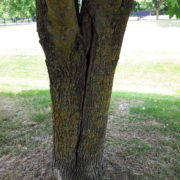This past May 4, 2018, southern Ontario experienced a severe windstorm that left a vast trail of damage to hydro lines, homes and trees. Winds in excess of 100km per hour were observed. In some areas winds were as high as 120km per hour. In many cases, downed trees and branches were directly responsible for inflicting damage to hydro lines and homes.
Mature Spruce Trees Were Particularly Affected
Alexander Tree Care started getting emergency calls within a very short time after the storm ended. The very first three calls involved uprooted spruce trees. In the aftermath, it became apparent to us that many calls involved evergreens rather than deciduous trees. Mature spruce trees were particularly affected. We began to question if there was a specific reason to this pattern or was it simply just a coincidence?
Dense evergreens and shrubs are recommended as excellent windbreaks around homes. While that may be so, are they less wind resistant than other trees like deciduous ones? We cannot draw conclusions solely from our own experience during one recent wind storm. There are just too many variables to consider and not enough information and data from any field studies to draw any reasonable conclusions.
Factors Which Can Contribute to the Failure of Trees and their Branches
The aforementioned, however, is a good segue to conduct a brief discussion on factors which can contribute to the failure of trees and branches during a severe weather event. It should be noted that even healthy trees with no signs of structural weakness or other issues can be affected during severe wind conditions. They are simply unable to withstand the destructive force caused by storms.
A Dense Canopy
A dense canopy can be less wind resistant than a thinned-out one. Reducing the density of the canopy by pruning improves air flow and reduces air drag.
Unbalanced Tree Structures
Balancing the structure of a tree is another simple solution to reduce the risk of tree failure. Many trees can have larger or more limbs on one side than the other causing uneven weight distribution. Selective removal of branches would be highly recommended to achieve balance.
Tree Decay
Trees with cavities, which may be home to nesting squirrels or birds, are a good indication of tree decay. Mushrooms or conks attached to trees are also a good indicator of decay. Decaying trees and branches are at higher risk of breaking under severe wind load conditions. For safety reasons removal of the tree with this condition may be the only viable option. Once tree decay occurs it is irreversible and can likely spread.
There are cases where decay is not always readily detected. A tree trunk may look healthy and sound but the roots may be rotted out due to soil fungus. Dig below the ground to detect if any decaying is taking place. The main culprit of soil fungus is overwatering or poor drainage. Removing nearby decaying material such as logs and stumps is also advisable to reduce the potential of fungi spreading.
“Twin Trunks”
Trees with twin trunks, referred to as codominant trunks, are known to have poor attachments and therefore are susceptible to cracking and failing. The cracks usually occur below the area where the tree trunk splits in two. In this location weakness occurs from the build-up of trapped bark known as included bark. Various birch and maple trees, like silver, red, sugar and Norway, are some examples of trees that can form codominant stems. At the beginning of this blog there is a photo of a Norway maple with codominant trunks and a very visible and prominent crack. There is also a crack on the other side of this tree. These cracks will only get wider as the trunks get larger and heavier. They also create openings for pathogens and insect infestation.
If you have any tree or shrub issues needing attention, don’t hesitate in contacting Alexander Tree Care for expert advice and service. Check out our web site for all of the services we offer. Our area of operation includes: Newmarket, Aurora, Richmond Hill, Markham, Vaughan, King City, King Township, East Gwillimbury, Bradford, Georgina, Stouffville, Uxbridge and Toronto.
Alexander Tree Care has been serving Toronto and York Region; including Newmarket, Aurora, Richmond Hill, Markham, Georgina, Vaughan, Bradford King City, King Township and areas for over 10 years. An ISA certified arborist will always be on any crew to perform expert tree and shrub service. For peace of mind we are fully insured and covered by WSIB. Don’t forget to follow what our customers have been saying about Alexander Tree Care. Check out our reviews on HomeStars and Google.
You can find us on Facebook, or click here to contact us.
Till next time,
Alexander


